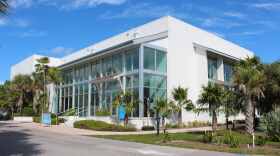Labor Day weekend plans usually involve family gatherings and barbecues. But for more than 100 people from all over the state, Labor Day included swooping into FGCU’s food forest in hopes of catching sight of a rare bird.
That Sunday, a friend told FGCU assistant professor of biology Oscar Johnson that he had seen a rare hummingbird in the food forest on campus. Johnson headed over there but quickly was surprised to find an even rarer bird, a native of South America.
"So I came to look for that, made it about 5 feet into the food forest, and this was the second bird I looked at. …a small-billed elaenia. It's a very drab, small, greenish gray flycatcher. It eats berries and insects," Johnson said.
"I knew what it was because I've done a lot of work in South America. I'm familiar with how to identify them, but obviously got extremely excited very quickly and put out the word on all the rare bird chats."

People showed up from as far away as the Panhandle, spending the rest of Sunday as well as Monday and even Tuesday hoping to catch a glimpse of the bird. Not many did.
"So out of the 110 120 people that came to look for it, I think about a third of the people actually saw it," Johnson said. "There were people who spent three days straight in the food forest, 12,15, hours of searching and never saw it."
The bird should not have ended up here. It should have migrated to southern South America instead of north to the U.S. It likely was alone here.
"Most birds do not migrate with their parents. They migrate on their own. So they need to know where to go, when to go, and how far to go," Johnson explained. "That is all genetically ingrained. So what we see quite often in birds like this is that they likely have a mutation that has caused them to misorient."
Mercedes Roesler, a senior in biology and president of the Ornithology Club at FGCU, was oneof those who rushed over to see the bird.
"I was actually at Culver's with my parents down the street, and I got the text that this bird had come into the food forest. And I said, 'Whoa, this is pretty crazy, right? I gotta get over there as soon as I can.' Unfortunately, I never got to see it. But I'm not so much about seeing the species as I am about just being around other people who love to see the birds."
She had plenty of company that day.
WGCU is your trusted source for news and information in Southwest Florida. We are a nonprofit public service, and your support is more critical than ever. Keep public media strong and donate now. Thank you.







